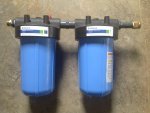I plan to purchase a filter to place on my garden hose this year to help keep the iron (and other things) down in the pool. I do not have a bunch of iron in my water, but I have seen light staining if I leave the hose running and sitting close to the steps or the bottom for a long time.
I have seen three brands out there - Pre Fresh, Pure Fill and ecoone. They all appear to have both activated carbon and a redox resin. Pre Fresh says it is good for 5000 to 8000 gallons and a flow rate of 2.5 gpm and costs about $30. Pure Fill says it is good for 1200 gallons, does not mention flow rate and costs about $15. The ecoone says it is good for 40,000 gallons, does not mention flow rate and costs about $33.
Has anyone used any of these? Any feedback?
Thanks
I have seen three brands out there - Pre Fresh, Pure Fill and ecoone. They all appear to have both activated carbon and a redox resin. Pre Fresh says it is good for 5000 to 8000 gallons and a flow rate of 2.5 gpm and costs about $30. Pure Fill says it is good for 1200 gallons, does not mention flow rate and costs about $15. The ecoone says it is good for 40,000 gallons, does not mention flow rate and costs about $33.
Has anyone used any of these? Any feedback?
Thanks


